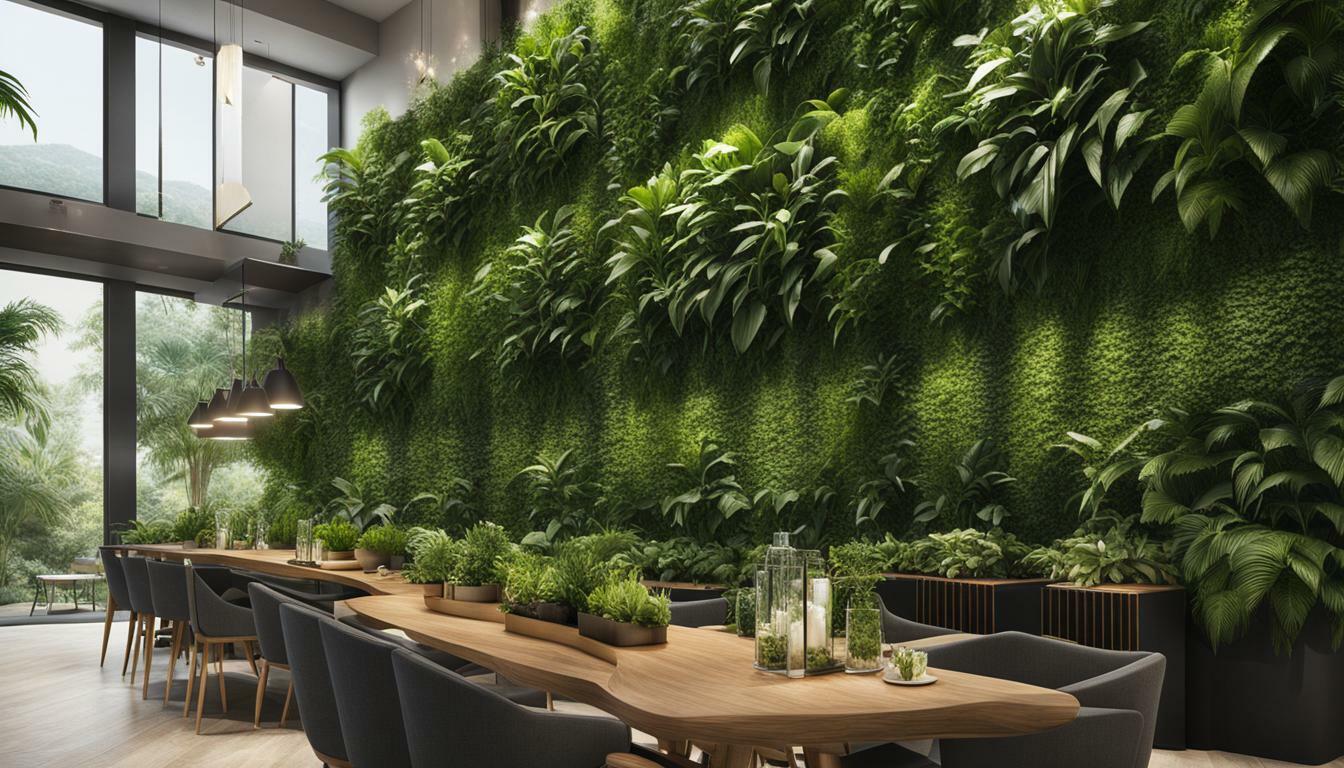Revolutionize Your Space: The Vertical Garden System Explained is a revolutionary way to transform your living space and bring the beauty of nature indoors. With vertical gardening, you can create a stunning display of plants that not only adds visual appeal but also provides numerous benefits. This eco-friendly and space-saving system allows you to grow a wide variety of plants in limited areas, making it perfect for urban dwellers or anyone looking to maximize their garden space.
Key Takeaways:
- Vertical garden systems are a game-changer for transforming living spaces and bringing nature indoors.
- Vertical gardening is an eco-friendly and space-saving way to grow a wide variety of plants.
- By utilizing vertical space, you can create a stunning display of plants that adds visual appeal to your living area.
- Vertical garden systems provide numerous benefits, including increased yields, reduced plant problems, and easier maintenance.
- Choosing the right plants and structures is essential for successful vertical gardening.
- Vertical hydroponics is a cutting-edge farming method that allows plants to grow without soil in a vertical fashion.
- Vertical hydroponics offers year-round plant production, controlled nutrient delivery, increased crop yields, and water conservation.
Grow Up! Benefits of Vertical Gardening
Vertical gardening offers numerous benefits that can revolutionize your gardening experience and maximize your plant growth. By utilizing vertical space and growing plants upwards on trellises, fences, or other structures, you can enjoy the following advantages:
Increased Yields
Making maximum use of space means a heartier harvest. Vertical gardening allows you to grow more plants in a smaller area, resulting in increased yields of your favorite fruits, vegetables, and herbs. By utilizing the vertical space, you can maximize the number of plants you grow and enjoy a bountiful harvest.
Fewer Plant Problems
Vertical gardening can help reduce common plant problems. By growing plants off the ground, they are less susceptible to diseases. Improved air circulation helps plants dry faster after watering, reducing the risk of moisture-loving fungi like powdery mildew and rusts. Additionally, pests and insects are more visible on vertical plants, allowing you to identify and address potential issues sooner.
More Leaf Surface
When plants are grown vertically, more leaf surface is exposed to sunlight. This increased exposure allows for better photosynthesis, resulting in healthier growth and higher productivity. More leaf surface area also means more opportunities for plants to absorb nutrients, resulting in stronger and more robust plants.
Easier on Your Back
Vertical gardening can save you from the strain and discomfort of bending and kneeling while tending to your plants. By growing plants at eye level or above, you can perform tasks such as watering, pruning, and harvesting while standing. This ergonomic advantage makes gardening more enjoyable and accessible for people with mobility issues or back problems.
While vertical gardening offers numerous benefits, it’s important to note that vertical gardens may require more frequent watering, especially those wall-mounted planters that receive less rain. Consider using micro or drip irrigation systems coupled with timers to ensure efficient and automated water delivery.
| Recommended Vertical Gardening Plants |
|---|
| Cherry Tomato: ‘Sungold’, ‘Black Cherry’, ‘Gardener’s Delight’, ‘Blondkopfchen’ |
| Cucumber: ‘Burpee Hybrid II’, ‘County Fair 83’, ‘Dasher 11’, ‘Saladin’ |
| Green Bean: ‘Romano Italian’, ‘Meraviglia Venezia’, ‘Gold of Bacau’ |
| Lima Bean: ‘Doctor Martin’, ‘King of the Garden’ |
| Melon: ‘Delicious 51’, ‘Tigger’, ‘Sleeping Beauty’ (musk melon); ‘White Wonder’, ‘Yellow Doll’ (watermelon) |
| Pea: ‘Dual’, ‘Garden Sweet’, ‘Maestro’, ‘Sugar Snap’, ‘Super Sugar Snap’ |
| Squash: acorn, delicata, yellow summer, zucchini |
Building Trellises and Supports for Climbing Vegetables
To support climbing vegetables in your vertical garden system, it’s essential to build sturdy trellises and other vertical support structures. These structures not only provide the necessary support for the plants but also help in maximizing space and optimizing growth. Here are some tips and techniques to consider:
- Choose the right materials: When building trellises and support structures, it’s important to select materials that are strong, durable, and weather-resistant. Popular options include bamboo, wood, metal, and PVC pipes. Consider the weight and size of the plants you’ll be growing to ensure the trellis can support their growth.
- Plan for vertical growth: Before constructing the trellis, determine the height and width requirements of your plants. This will help you design a trellis that provides ample space for the plants to climb and spread. Consider the spacing between the trellis wires or slats, ensuring they are close enough together to support the plants but also allow for easy access and harvesting.
- Secure the trellis properly: When installing the trellis, ensure it is securely anchored to the ground or wall to prevent it from toppling over. Use stakes, hooks, or brackets to secure the trellis firmly in place. If using a wall-mounted trellis, make sure it is attached to a solid structure that can support the weight of the plants.
- Consider plant-specific supports: Different climbing vegetables have varying growth patterns and requirements. Some may have tendrils that require thin wires or strings for support, while others may need wider slats or mesh for their foliage to cling onto. Take into account the specific needs of your plants and tailor the trellis and support structures accordingly.
Building trellises and support structures for climbing vegetables in your vertical garden system not only supports the growth of your plants but also helps in maximizing space and increasing yields. By selecting the right materials, planning for vertical growth, securing the trellis properly, and considering plant-specific supports, you can create a strong and efficient support system for your climbing vegetables.
Example Trellis Design
| Vegetable | Trellis Design |
|---|---|
| Pole Beans | Vertical poles with nylon netting or strings tied horizontally between them |
| Climbing Peas | A-frame trellis made from wooden stakes or bamboo with twine or netting wrapped around |
| Cucumbers | Vertical trellis made from bamboo poles tied together in a teepee shape |
| Vining Tomatoes | Cage trellis made from sturdy wire or metal for support |
Quote:
To ensure the success of your vertical garden, it’s crucial to invest time and effort into building strong and reliable trellises and support structures. These structures not only provide the necessary support for climbing vegetables but also contribute to the overall aesthetic appeal of your garden.
Urban Gardening: Cram More Into a Small Vegetable Garden!
Urban gardening is becoming increasingly popular as people look for ways to grow their own fresh produce in small spaces, and vertical garden systems are the perfect solution for maximizing limited garden areas. These innovative systems allow gardeners to grow plants in a vertical direction, utilizing walls, fences, trellises, and other structures to create a productive garden in even the smallest of spaces.
Vertical gardening offers a range of benefits for urban gardeners. One of the key advantages is increased yields. By growing plants vertically, you can make maximum use of the available space, resulting in a heartier harvest. Additionally, tending to a vertical garden is easier on your back as plants are elevated, minimizing the need for bending and kneeling.
Vertical gardening also helps to reduce plant problems. By keeping foliage and fruit off the ground, plants are less susceptible to diseases and pests. The upward growth of plants allows for better air circulation, which helps to prevent moisture-loving fungi from taking hold. Disease symptoms and pest infestations are also more visible in a vertical garden, allowing for early intervention and effective management.
Growing plants vertically exposes more leaf surface to the sun, promoting healthier growth. When plants are not sprawling on the ground, they can receive more sunlight, which is essential for photosynthesis and overall plant health.
Space-Saving Techniques
When it comes to urban gardening, utilizing space-saving techniques is vital. One of the best ways to maximize space in a small vegetable garden is by choosing vining plants over bush-type crops. Vining plants, such as pole beans, climbing peas, and vining tomatoes, can be trained to grow up trellises or other vertical supports, reducing the amount of horizontal space they occupy.
When selecting crops for vertical gardening, it’s important to consider their sunlight requirements. Most vegetables need 6 to 8 hours of direct sunlight each day. Choose a location that receives ample sunlight, such as a surface facing the midday or afternoon sun, to ensure optimal plant growth. The heat absorbed during the day will also be reflected back onto the plants at night, promoting faster growth and a bountiful harvest.
Recommended crops for vertical gardening include cherry tomatoes, cucumbers, green beans, lima beans, melons, peas, and various types of squash. These crops are well-suited for vertical growth and can be trained to climb up supports, saving valuable space in a small vegetable garden.
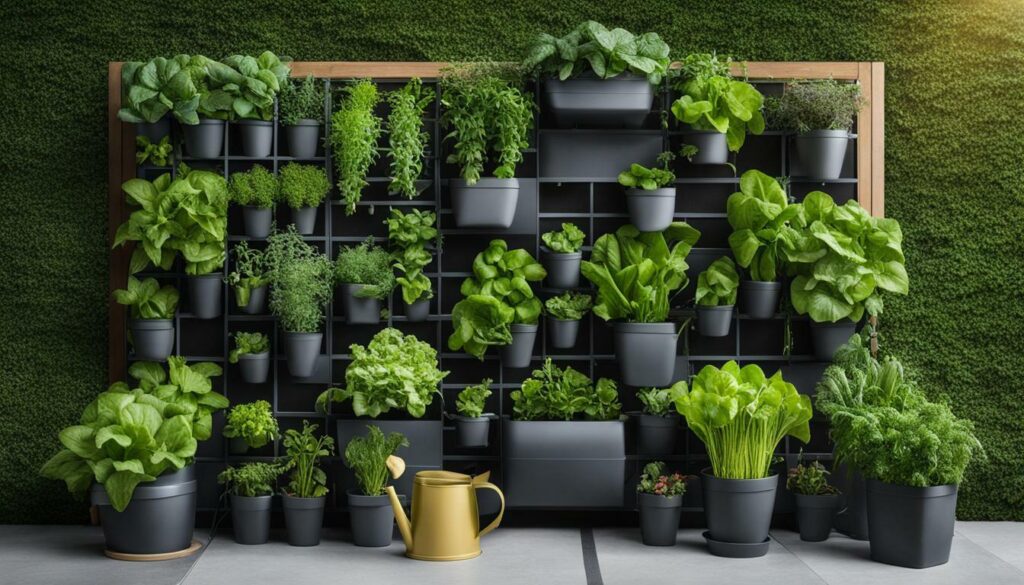
Creating a thriving vertical garden requires the use of appropriate structures and supports. Trellises, arches, pergolas, wire cages, and netting are commonly used in vertical gardening. The choice of structure depends on the characteristics of the plants being grown. For example, trellises are ideal for plants with tendrils, such as pole beans and sweet peas, while sturdier structures like arches and pergolas are suitable for heavier plants like grapevines.
Types of Vertical Gardening Structures
| Structure | Best Plants |
|---|---|
| Trellises | Pole beans, Sweet peas |
| Arches, Pergolas | Grapevines, Climbing roses |
| Wire Cages | Tomatoes, Cucumbers |
| Netting | Peas, Beans |
By matching the appropriate structure with the specific plant’s needs, gardeners can cultivate a thriving vertical garden.
Do-it-yourself (DIY) enthusiasts will be delighted to discover the wide range of creative ideas for vertical gardening. From living walls and vegetable arches to trellis panels and gutter gardens, there are endless possibilities. These DIY projects allow individuals to customize their vertical gardens to suit their space and aesthetic preferences. Whether you have a small balcony or a backyard, you can transform any area into a flourishing vertical garden.
With vertical gardening, even those with limited gardening space can enjoy the benefits of fresh, homegrown produce. Embrace the urban gardening trend and discover the joys of growing your own vertical garden.
Plant Supports: It’s a Holdup!
Proper plant support is crucial in vertical gardening to ensure the healthy growth and stability of your plants. Vertical gardening involves growing plants in a vertical plane, using trellises, cages, or other support structures to guide their upward growth. By providing the right support, you can prevent plants from sprawling on the ground, increase air circulation, and maximize sunlight exposure – all of which contribute to healthier plants and increased yields.
One of the main advantages of using plant supports in vertical gardening is the reduction in plant problems. When plants are lifted off the ground, they are less susceptible to diseases caused by moisture-loving fungi, such as powdery mildew and rusts. Improved air circulation helps plants dry faster after watering, minimizing the risk of fungal growth. Additionally, better visibility of the plants makes it easier to spot any signs of disease or pest infestation, allowing for prompt intervention.
Here are some common types of plant supports used in vertical gardening:
- Cages: Wire or wooden cages provide a sturdy structure for supporting tall and heavy plants, such as tomatoes or peppers. They help prevent the plants from toppling over under their own weight.
- Trellises: Trellises are vertical structures with a series of horizontal bars or wires. They are ideal for training climbing vegetables, such as beans or cucumbers, to grow upwards. Choose trellises that are strong enough to support the weight of the plants.
- Netting: Netting can be draped over a framework to create a support structure for vining plants. It allows the plants to weave through the openings, providing natural support as they grow.
Proper plant support techniques involve securing the plants to the supports as they grow. Soft ties, such as garden twine or plant clips, can be used to loosely fasten the stems to the support structure. It’s important not to tie them too tightly, as this can restrict growth and damage the plants. Regularly check the plant supports and adjust them as needed to accommodate the plants’ growth.
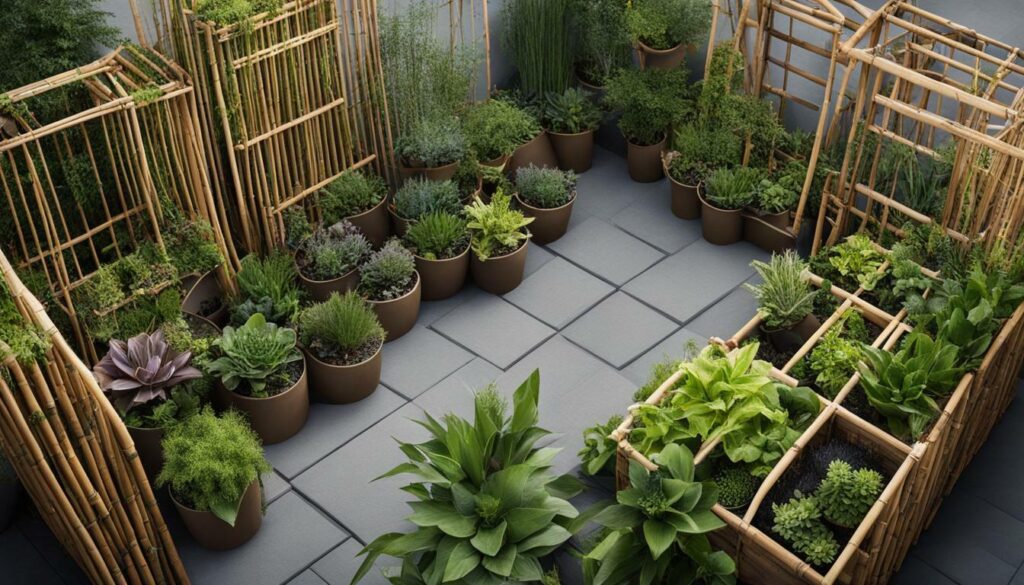
Table: Suitable Plant Supports for Vertical Gardening
| Plant | Suitable Supports |
|---|---|
| Pole Beans | Trellises, cages |
| Climbing Peas | Trellises, netting |
| Sweet Potatoes | Trellises, cages |
| Vining Tomatoes | Trellises, netting |
| Zucchini, Cucumber, Melon, and Squash | Cages, trellises |
“Proper plant support is crucial in vertical gardening to ensure the healthy growth and stability of your plants.”
By providing the right support structures and techniques, you can create a thriving vertical garden that not only maximizes space but also enhances plant health and productivity. Whether you choose cages, trellises, or netting, investing in proper plant supports is essential for a successful vertical gardening experience.
Which Plants Are Best for Vertical Gardening?
Choosing the right plants is essential for successful vertical gardening, and vining plants are particularly well-suited for this type of cultivation. Vining plants have a natural tendency to climb and spread, making them perfect for vertical growth on trellises, arches, and other support structures. These plants not only maximize space but also add a beautiful aesthetic to your garden.
Here are some of the best vining plants for vertical gardening:
- Pole Beans: Pole beans are vigorous climbers that produce a bountiful harvest. Varieties like ‘Romano Italian’, ‘Meraviglia Venezia’, and ‘Gold of Bacau’ are great options.
- Climbing Peas: Climbing peas, such as ‘Dual’, ‘Garden Sweet’, ‘Maestro’, ‘Sugar Snap’, and ‘Super Sugar Snap’, thrive in vertical gardens, offering delicious pods to enjoy.
- Sweet Potatoes: Sweet potatoes can be grown vertically by using trellises or vertical towers. They are low-maintenance plants that produce tasty tubers.
- Vining Tomatoes: Vining tomato varieties, like ‘Sungold’, ‘Black Cherry’, ‘Gardener’s Delight’, and ‘Blondkopfchen’, can be trained to grow upwards, saving valuable space.
- Squash: Certain types of squash, including acorn, delicata, yellow summer, and zucchini, can be trained to grow vertically, offering a compact and efficient way to grow these delicious vegetables.
- Cucumbers: Cucumbers like ‘Burpee Hybrid II’, ‘County Fair 83’, ‘Dasher 11’, and ‘Saladin’ can be grown vertically, allowing for easy harvesting and saving garden space.
- Melons: Some melon varieties, such as ‘Delicious 51’, ‘Tigger’, ‘Sleeping Beauty’ (musk melon), ‘White Wonder’, and ‘Yellow Doll’ (watermelon), can be trained to climb vertical supports, providing ample fruit in a small area.
These vining plants are just a few examples of the many options available for vertical gardening. Remember to provide proper support and training for these plants to ensure their upward growth and maximize your garden’s potential.
Table: Recommended Vining Plants for Vertical Gardening
| Plant | Varieties |
|---|---|
| Pole Beans | ‘Romano Italian’, ‘Meraviglia Venezia’, ‘Gold of Bacau’ |
| Climbing Peas | ‘Dual’, ‘Garden Sweet’, ‘Maestro’, ‘Sugar Snap’, ‘Super Sugar Snap’ |
| Sweet Potatoes | N/A |
| Vining Tomatoes | ‘Sungold’, ‘Black Cherry’, ‘Gardener’s Delight’, ‘Blondkopfchen’ |
| Squash | Acorn, delicata, yellow summer, zucchini |
| Cucumbers | ‘Burpee Hybrid II’, ‘County Fair 83’, ‘Dasher 11’, ‘Saladin’ |
| Melons | ‘Delicious 51’, ‘Tigger’, ‘Sleeping Beauty’ (musk melon), ‘White Wonder’, ‘Yellow Doll’ (watermelon) |

Types of Vertical Gardening Structures
Vertical gardening offers a wide range of structure options to support your plants and create an aesthetically pleasing garden. From trellises and arches to pergolas, wire cages, and netting, there are various structures available to suit different plant characteristics and gardening preferences.
Trellises
Trellises are popular vertical gardening structures that provide support for climbing vegetables like pole beans and sweet peas. They can be bought or homemade from woody pruning and are ideal for plants with tendrils that need to be trained to grow upward. Trellises are lightweight and easy to install, making them a versatile choice for vertical gardening.
Arches and Pergolas
For more substantial plants like grapevines, arches and pergolas are excellent options. These structures add an architectural element to your garden while providing sturdy support for climbing plants. Arch-shaped structures are particularly suitable for creating shaded walkways or defining garden entrances. When choosing arches or pergolas, ensure they can withstand the weight of mature plants and are securely anchored to prevent toppling over.
Wire Cages
Wire cages are another type of vertical gardening structure that can be used to support plants. They are commonly used for fruit trees like apples, pears, and cherries, which can be trained against a wall or fence or along free-standing wire supports. Wire cages allow for flexibility in shaping the plants and are suitable for various forms of fence-hugging fruit tree training, such as single-stemmed cordons, fan shapes, and espaliers.
Netting
Netting is a versatile vertical gardening structure that can be used to support a variety of plants, including vining vegetables and flowers. It provides a lightweight and flexible option for vertical gardening and can be easily attached to existing structures or frames. Netting allows plants to grow freely while providing support for their upward growth.
To choose the right vertical gardening structure, consider the characteristics of your plants and the aesthetic you want to achieve in your garden. Whether you opt for trellises, arches, pergolas, wire cages, or netting, ensure that the structure matches the needs of your plants and enhances the overall beauty of your vertical garden.
| Plant | Recommended Varieties |
|---|---|
| Cherry Tomato | Sungold, Black Cherry, Gardener’s Delight, Blondkopfchen |
| Cucumber | Burpee Hybrid II, County Fair 83, Dasher 11, Saladin |
| Green Bean | Romano Italian, Meraviglia Venezia, Gold of Bacau |
| Lima Bean | Doctor Martin, King of the Garden |
| Melon | Delicious 51, Tigger, Sleeping Beauty (musk melon); White Wonder, Yellow Doll (watermelon) |
| Pea | Dual, Garden Sweet, Maestro, Sugar Snap, Super Sugar Snap |
| Squash | Acorn, Delicata, Yellow Summer, Zucchini |

Vertical gardening structures provide support and aesthetics to your garden, allowing you to make the most of your available space. Trellises, arches, pergolas, wire cages, and netting are just a few examples of the options you have. Depending on the characteristics of your plants and your desired garden design, you can choose the structure that best suits your needs. Remember to select sturdy structures for heavier plants, like grapevines, and to ensure proper anchoring to prevent any accidents. With the right vertical gardening structure, you can create a beautiful and productive garden in even the smallest of spaces.
DIY Vertical Gardening Ideas
Get creative with DIY vertical gardening projects that can enhance the beauty of your space and provide a thriving garden. Whether you have a small balcony or a spacious backyard, these ideas will help you make the most of your vertical space.
1. Make a Living Wall
One popular option for vertical gardening is creating a living wall. This involves using a trellis panel secured onto a wall to support a range of pots planted with herbs, vegetables, and flowers. To create a living wall, choose an appropriate-sized panel and give it a coat of wood stain or paint to protect it and make it stand out. Next, drill holes into the wall and screw in strong L-shaped hooks. Hang up your panel and plant pots with your chosen crops. Secure the pots to the trellis with sturdy garden twine, and don’t forget to water them regularly. With a living wall, you can enjoy a beautiful display of greenery and harvest fresh produce right from your wall.
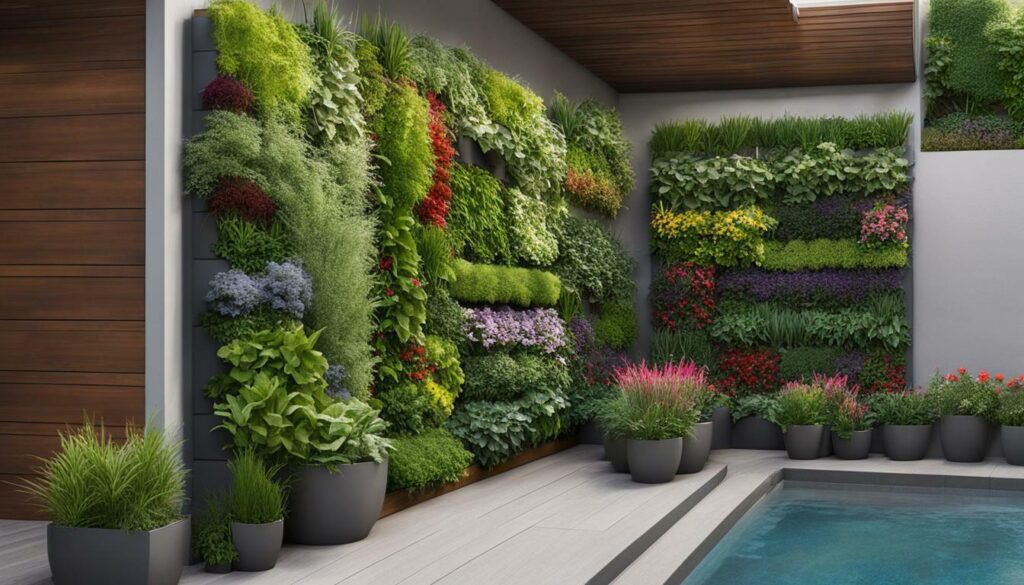
2. Make a Vegetable Arch
Another creative idea for vertical gardening is building a vegetable arch. This project involves using galvanized metal uprights and cattle panels to create an archway that can be clad with climbing crops like beans, cucumbers, and squash. Locate your vegetable archway in a sunny and sheltered spot, dig planting trenches on either side of the arch, and drive the uprights into the ground. Backfill the trenches with nutrient-rich organic matter and soil, and cut the cattle panels to size. Secure the panels to the posts using zip ties and plant your climbing vegetables in the prepared trenches. Add a layer of mulch to lock in moisture and enjoy the convenience of easy picking and a stunning garden feature.
3. Create a Gutter Garden
If you have limited space, a gutter garden is a fantastic vertical gardening option. Install gutters horizontally on a wall or fence, and plant your choice of herbs, salad greens, or small vegetables in the gutters. This method allows you to maximize space by using the vertical surface effectively. Ensure proper drainage by drilling holes in the bottom of the gutters and adding a layer of gravel before filling them with soil. Water the plants regularly and watch as your gutter garden thrives.
4. Build a Trellis Panel
A trellis panel is a versatile vertical gardening solution that can be used to support a variety of climbing plants. You can easily build a trellis panel using wooden slats or metal rods. Attach the panel to a wall or fence, ensuring it is securely fastened. Plant your chosen climbing plants at the base of the trellis and guide their growth by tying them to the panel as they grow. This DIY project allows you to add height and visual interest to your garden while providing support for your plants.
| Vining Plants: | Bush-Type Crops: |
|---|---|
| Pole Beans | Acorn Squash |
| Climbing Peas | Delicata Squash |
| Sweet Potatoes | Yellow Summer Squash |
| Vining Tomatoes | Zucchini |
| Sprawling Zucchini | |
| Cucumber | |
| Melon |
Recommended Plants for Vertical Gardening
- Cherry Tomato: ‘Sungold’, ‘Black Cherry’, ‘Gardener’s Delight’, ‘Blondkopfchen’
- Cucumber: ‘Burpee Hybrid II’, ‘County Fair 83’, ‘Dasher 11’, ‘Saladin’
- Green Bean: ‘Romano Italian’, ‘Meraviglia Venezia’, ‘Gold of Bacau’
- Lima Bean: ‘Doctor Martin’, ‘King of the Garden’
- Melon: ‘Delicious 51’, ‘Tigger’, ‘Sleeping Beauty’ (musk melon); ‘White Wonder’, ‘Yellow Doll’ (watermelon)
- Pea: ‘Dual’, ‘Garden Sweet’, ‘Maestro’, ‘Sugar Snap’, ‘Super Sugar Snap’
- Squash: Acorn, Delicata, Yellow Summer, Zucchini
Whether you choose to create a living wall, a vegetable arch, a gutter garden, or a trellis panel, DIY vertical gardening projects provide endless possibilities for transforming your space and enjoying the rewards of a thriving garden.
What is Vertical Hydroponics?
Vertical hydroponics is a revolutionary farming method that allows plants to grow without soil, providing numerous benefits and efficient use of resources. In this system, plants are grown in a vertical fashion, using a tower or other vertical structure to support the plants. Instead of soil, plants are provided with the necessary nutrients through a water-based solution that is circulated throughout the system.
This innovative method of farming has gained popularity due to its ability to maximize space and increase crop yields. By growing plants vertically, gardeners can make the most of limited space, making it ideal for urban environments or small gardens. Vertical hydroponics also offers better control over nutrients, water usage, and environmental conditions, resulting in healthier and more productive plants.
One of the key advantages of vertical hydroponics is its efficient use of resources. Compared to traditional soil-based farming, vertical hydroponics uses up to 90% less water while still delivering the necessary nutrients to plants. This water-saving feature makes it an environmentally friendly option and can be especially beneficial in areas with limited water resources or in drought-prone regions.
Benefits of Vertical Hydroponics
| Benefits | Description |
|---|---|
| Increased Crop Yields | Vertical hydroponics allows for higher-density planting, maximizing the use of available space and resulting in greater crop yields. |
| Year-round Plant Production | Vertical hydroponics eliminates the limitations of weather and seasonality, allowing for year-round plant production regardless of outdoor conditions. |
| Controlled Nutrient Supply | With vertical hydroponics, gardeners have precise control over the nutrient supply to plants, ensuring optimal growth and health. |
| Water Conservation | Vertical hydroponics uses significantly less water compared to traditional soil-based farming, making it a more sustainable and water-efficient method of cultivation. |
| Increased Crop Yields | Vertical hydroponics allows for higher-density planting, maximizing the use of available space and resulting in greater crop yields. |
| Disease Prevention | By eliminating soil, vertical hydroponics reduces the risk of soil-borne diseases and pests, leading to healthier plants and reduced need for pesticides. |
Vertical hydroponics offers a range of benefits and is a versatile farming method that can be adapted to various environments and plant varieties. Whether you are growing herbs, vegetables, or even fruit trees, the vertical hydroponics system can revolutionize your gardening experience and provide a sustainable and efficient way to cultivate plants.
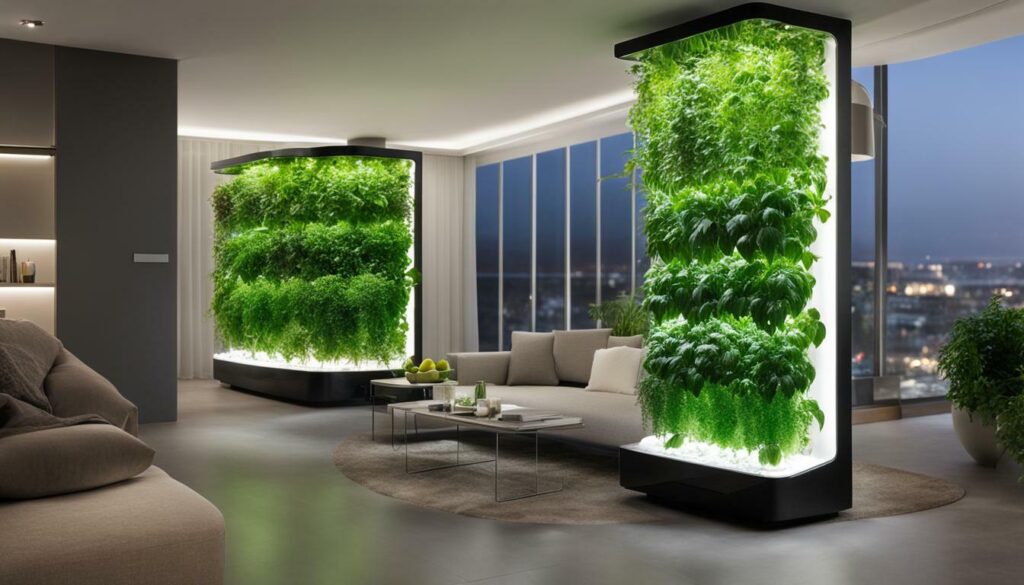
How Does It Work?
Understanding the workings of vertical hydroponics is essential to successfully implement this innovative farming method. Vertical hydroponics is a system that utilizes a tower-like structure to grow plants vertically without the use of soil. Instead, plants are grown in a nutrient-rich water solution, allowing for efficient water use and nutrient delivery.
In a vertical hydroponic system, a tube is connected to a small water reservoir at the bottom. A hydroponic pump assists in pumping the water to the top of the system. From there, gravity comes into play, allowing the water to flow down in a controlled manner back to the reservoir. This downward flow provides the plants with the necessary nutrients for growth.
The plants in a vertical hydroponic system are placed in net cups angled at 45 degrees, allowing for easy flow of water through the roots. This system maximizes space utilization, making it ideal for small gardens or indoor gardening. It also promotes efficient water use, with some systems utilizing up to 90 percent less water compared to traditional soil-based cultivation methods.
Vertical Hydroponic System Diagram:
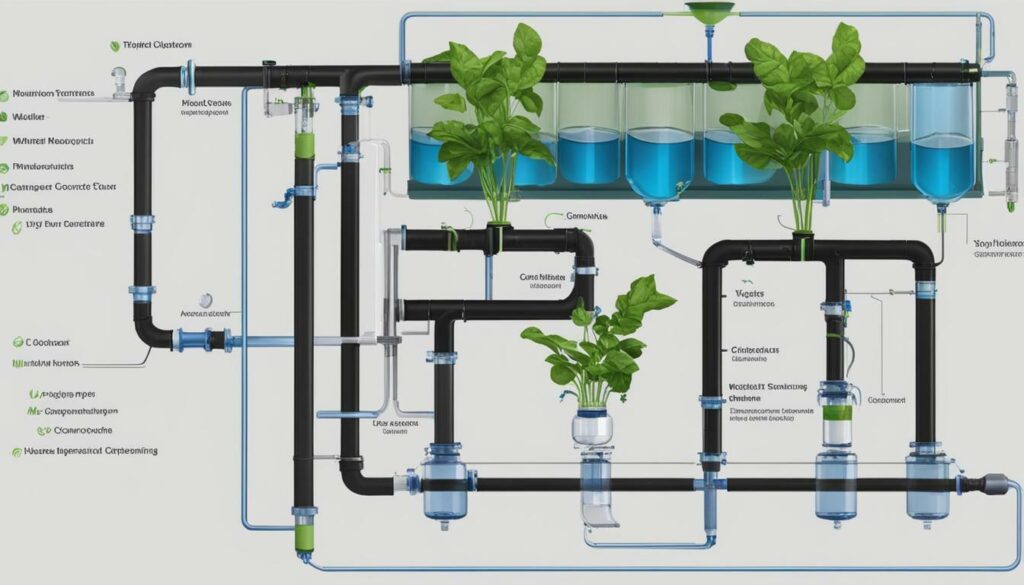
| Advantages of Vertical Hydroponics: |
|---|
| 1. Efficient use of water, with up to 90 percent less water consumption compared to traditional soil-based cultivation. |
| 2. Year-round plant production, enabling cultivation regardless of seasonal limitations. |
| 3. Controlled nutrient supply, allowing for optimal plant growth and healthier crops. |
| 4. Increased crop yield per area, maximizing space utilization. |
| 5. Disease prevention, as soil-borne diseases are eliminated in a soil-less hydroponic system. |
Vertical hydroponics offers numerous advantages over traditional soil-based cultivation, making it an ideal choice for modern farming. By implementing this innovative farming method, growers can enjoy higher yields, efficient resource utilization, and the ability to cultivate crops year-round, regardless of limited space or seasonal constraints.
Why Should I Use It?
There are numerous reasons why vertical hydroponics is a game-changer in the world of farming, offering unmatched benefits and revolutionizing food production. Here are some of the key advantages:
- Year-round plant production: Vertical hydroponics allows for continuous cultivation regardless of the season. With controlled environments, you can grow crops all year long, ensuring a constant supply of fresh produce.
- Controlled nutrients: In a vertical hydroponic system, you have complete control over the nutrient supply to the plants. This means you can tailor the nutrient solution to meet the specific needs of each crop, ensuring optimal growth and nutrient uptake.
- Water conservation: Vertical hydroponics is incredibly water-efficient, using up to 90% less water compared to traditional soil-based farming. The recirculating water system in hydroponics minimizes water waste and allows for efficient nutrient delivery to the plants.
- Increased crop yield: Vertical hydroponics maximizes space utilization by growing plants vertically, allowing for higher plant densities and increased crop yield per square foot compared to traditional farming methods.
- Disease prevention: With the absence of soil, vertical hydroponics eliminates the risk of soil-borne diseases and pests that can impact crop health. This reduces the need for chemical pesticides and fungicides, making for healthier and safer produce.
By harnessing the power of vertical hydroponics, you can enjoy a consistent supply of fresh, nutrient-rich produce, reduce water consumption, and minimize the risk of crop diseases. Whether you have limited outdoor space or want to optimize your indoor gardening efforts, vertical hydroponics offers a sustainable and efficient solution.
“A vertical garden makes green space accessible to the masses and as attention continues to turn to where our food comes from, we’re not hugely surprised that people are now thinking about what more their living walls can offer them.” – Matt Lindsay, General Manager at Growing Revolution
DIY Vertical Hydroponic Ideas
If you’re interested in exploring vertical hydroponics, here are some simple and creative DIY ideas to get you started:
- Stacked Hydroponic Set-Up: Create a vertical hydroponic system by stacking plants one on top of the other. This space-efficient set-up is perfect for small gardens and can easily be assembled with a kit from a gardening store.
- A-Frame Hydroponic System: Build an A-frame structure with multiple layers of pipes to maximize growing space. This system allows for higher plant densities and increased crop production.
- Zig-Zag Hydroponic System: Utilize PVC pipes arranged in a zig-zag pattern to create a space-efficient vertical hydroponic system. This DIY set-up is suitable for growing a variety of crops.
- Rain Tower Hydroponic Set-Up: Construct a tall tube-shaped hydroponic system that efficiently utilizes water flow. This set-up is simple to build and highly efficient.
- Vertical Gutter Garden: Repurpose gutters to create a vertical hydroponic system. This DIY project is a great way to upcycle materials and create a unique garden display.
| Crop | Varieties |
|---|---|
| Cherry tomato | ‘Sungold’, ‘Black Cherry’, ‘Gardener’s Delight’, ‘Blondkopfchen’ |
| Cucumber | ‘Burpee Hybrid II’, ‘County Fair 83’, ‘Dasher 11’, ‘Saladin’ |
| Green bean | ‘Romano Italian’, ‘Meraviglia Venezia’, ‘Gold of Bacau’ |
| Lima bean | ‘Doctor Martin’, ‘King of the Garden’ |
| Melon | ‘Delicious 51’, ‘Tigger’, ‘Sleeping Beauty’ (musk melon); ‘White Wonder’, ‘Yellow Doll’ (watermelon) |
| Pea | ‘Dual’, ‘Garden Sweet’, ‘Maestro’, ‘Sugar Snap’, ‘Super Sugar Snap’ |
| Squash | Acorn, delicata, yellow summer, zucchini |
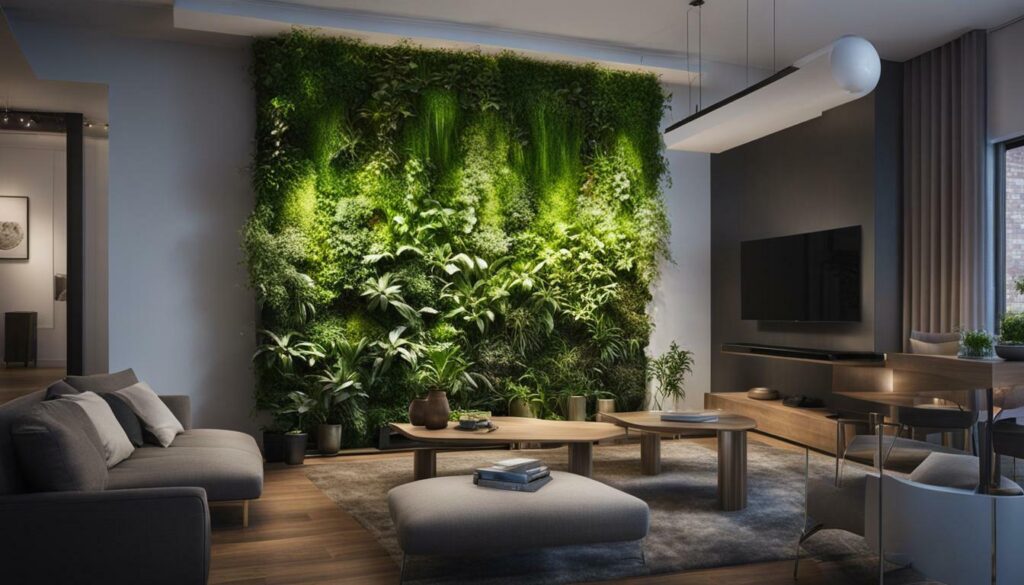
With these DIY ideas and a variety of suitable crops, you can start your journey into vertical hydroponics. Enjoy the benefits of year-round plant production, controlled nutrients, water conservation, increased crop yield, and disease prevention. Vertical hydroponics truly revolutionizes the way we grow food and presents an eco-friendly and efficient solution for all gardening enthusiasts.
Conclusion
Vertical garden systems, particularly when combined with vertical hydroponics, are an innovative and eco-friendly way to transform your living space and cultivate a thriving garden. By utilizing vertical space, these systems revolutionize the way we think about gardening, offering numerous benefits and opportunities for both outdoor and indoor cultivation.
The benefits of vertical gardening include increased yields, reduced plant problems, improved plant growth, and ergonomic advantages. Vertical gardens allow for maximum use of space, resulting in a heartier harvest. The upward growth of plants in vertical gardens provides better air circulation, reducing the risk of disease. Additionally, more leaf surface is exposed to the sun, promoting healthier growth. Vertical gardening also eliminates the need for excessive bending and kneeling, making it easier on your back.
When it comes to choosing plants for vertical gardening, vining plants are ideal as they can be trained to grow up and off the ground. This allows for better space utilization compared to bush-type crops. Recommended crops for vertical gardening include pole beans, climbing peas, vining tomatoes, and sprawling varieties of zucchini, cucumber, melon, and squash.
Vertical gardening structures, such as trellises, arches, pergolas, wire cages, and netting, play a crucial role in supporting plants and maximizing vertical space. The choice of structure should be based on the characteristics of the plant and its growth habits to ensure optimal growth.
If you’re feeling creative, there are plenty of DIY vertical gardening ideas to explore. You can create a living wall by using a trellis panel and planting pots with herbs, vegetables, and flowers. Another option is to build a vegetable arch using galvanized metal uprights and cattle panels, providing support for climbing crops. Other DIY ideas include using trellis panels, creating a gutter garden, or setting up a hydroponic system using PVC pipes and net cups.
Vertical hydroponics takes gardening to the next level by allowing plants to grow without soil, using a water-based nutrient solution. This system utilizes gravity to deliver water and nutrients to the plants in a controlled manner. Vertical hydroponics offers numerous benefits, including year-round plant production, controlled nutrient supply, water conservation, increased crop yield, and disease prevention.
In conclusion, vertical garden systems and vertical hydroponics provide an exciting opportunity to transform your space into a thriving and eco-friendly garden. Whether you have a small urban garden or a limited indoor space, these systems offer a practical and efficient way to grow plants, maximize space, and embrace a sustainable lifestyle.
How Does the Vertical Garden Box Revolution Compare to the Vertical Garden System?
The Vertical Garden Box Revolution is an innovative way to maximize your space with vertical garden box. This system allows for easy customization and is perfect for small spaces. On the other hand, the Vertical Garden System offers a more traditional approach with pre-designed layouts and materials. Both options have their own unique benefits.
FAQ
Q: What is vertical gardening?
A: Vertical gardening is a method of gardening that utilizes vertical space to maximize growing area. It involves growing plants vertically on structures such as trellises, arches, and living walls.
Q: What are the benefits of vertical gardening?
A: Vertical gardening offers several benefits, including increased yields, reduced plant problems, better air circulation, and easier maintenance and harvesting. It also allows for efficient use of space and is easier on the gardener’s back.
Q: What plants are best for vertical gardening?
A: Vining plants such as pole beans, climbing peas, vining tomatoes, and trailing varieties of zucchini, cucumber, melon, and squash are ideal for vertical gardening. These plants can be trained to grow up trellises and supports.
Q: What structures can be used for vertical gardening?
A: There are various structures that can be used for vertical gardening, including trellises, arches, pergolas, wire cages, netting, and wall-mounted planters. The choice of structure depends on the characteristics of the plants being grown.
Q: How do I build a vertical garden?
A: There are several DIY vertical gardening ideas that you can try, such as creating a living wall, building a vegetable arch, using a trellis panel, or setting up a gutter garden. Each project requires specific materials and steps, which can be found in online tutorials or gardening guides.
Q: What is vertical hydroponics?
A: Vertical hydroponics is a method of growing plants without soil in a vertical fashion. It involves using a hydroponic tower or system to deliver water and nutrients to the plants, allowing for efficient water use and increased crop yield.
Q: How does vertical hydroponics work?
A: In vertical hydroponics, water is pumped to the top of the system and flows down in a controlled manner, delivering nutrients to the plants. The plants are placed in net cups or pipes, and gravity helps facilitate the downward flow of water.
Q: What are the benefits of vertical hydroponics?
A: Vertical hydroponics offers several benefits, including year-round plant production, controlled nutrient supply, water conservation, increased crop yield, and disease prevention. It is also suitable for both indoor and outdoor gardening.
Q: What are some DIY vertical hydroponic set-ups?
A: Some DIY vertical hydroponic set-ups include stacked hydroponic systems, A-frame systems, zig-zag systems, rain tower systems, and vertical gutter gardens. These set-ups can be customized to fit your space and gardening needs.
Q: How do I choose the right plants for vertical hydroponics?
A: When selecting plants for vertical hydroponics, choose varieties that are well-suited for this type of growing system, such as leafy greens, herbs, strawberries, and small fruits. Consider factors such as light requirements, space availability, and nutrient needs.
Q: Is vertical gardening suitable for small spaces?
A: Yes, vertical gardening is especially suitable for small spaces, such as balconies, patios, and rooftops. It allows you to maximize growing area and grow a variety of plants in a compact space.

